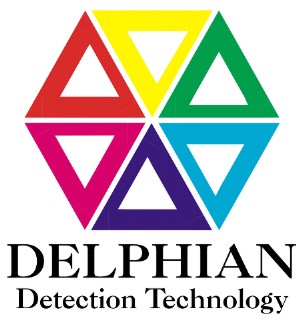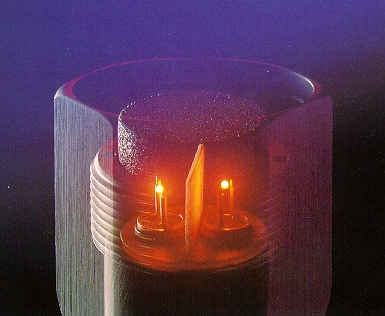|
Combustible
Gas Basics
A combustible gas is one that will burn when mixed with air (or oxygen) and ignited.
Combustible gas-air mixtures can be burned over a wide range of concentrations. The actual
minimum concentration varies from about 0.5% to about 15% by volume in air for most common
CHCs. This concentration is always referred to as 100%
LEL or LFL
for that gas.
FLAMMABLE/EXPLOSIVE LIMITS
OF VARIOUS GASES & VAPORS
(measured in % of volume by air) |
| |
Compounds |
|
LFL/LEL |
UFL/UEL |
| Alcohol |
Methanol |
CH3OH |
6.7 |
36 |
| |
Ethanol |
CH3CH2OH |
3.3 |
19 |
| |
Propanol |
CH3CH2CH2OH |
2.2 |
14 |
| Esters |
Ethyl Acetate |
CH3COOC2H5 |
2.2 |
11 |
| Ethers |
Ethyl Ether |
CH3CH2OCH2CH3 |
1.9 |
36 |
| |
Methyl Ether |
CH3OCH3 |
3.4 |
27 |
| Hydrocarbons |
Methane |
CH4 |
5.0 |
15 |
| |
Propane |
CH3CH2CH3 |
2.1 |
9.5 |
| |
Butane |
CH3CH2CH2CH3 |
1.8 |
8.4 |
| |
Hexane |
CH3CH2CH2CH2CH2CH3 |
1.2 |
7.4 |
| |
Heptane |
CH3CH2CH2CH2CH2CH2CH3 |
1.05 |
6.7 |
| |
Acetylene |
HC=CH |
2.5 |
100 |
| |
Gasoline (unleaded) |
|
1.2 |
7.1 |
| |
Jet Fuel (JP-4) |
|
1.3 |
8 |
| |
Naphtha |
|
1.7 |
4.8 |
| |
Turpentine |
|
0.7 |
|
| Cyclic Compounds |
Toluene |
C6H5CH3 |
1.2 |
7.1 |
| |
Xylene |
C6H4(CH3)2 |
1.1 |
6.4 |
| |
Ethylene Oxide |
CH2OCH2 |
3.6 |
100 |
| Ketones |
Acetone |
CH3COCH3 |
2.6 |
13 |
| |
Methyl Ethyl Ketone |
CH3COC2H5 |
1.4 |
10 |
| Inorganic Gases |
Carbon Monoxide |
CO |
12.5 |
74 |
| |
Hydrogen Sulfide |
H2S |
4.0 |
44 |
| |
Ammonia |
NH3 |
15 |
28 |
| |
Hydrogen |
H2 |
4 |
75 |
Combustible Gas
Detector Setpoints
Combustible gas-air mixtures can be burned over a wide range of concentrations. For each
there is a specific minimum concentration above which an ignition source will cause an
explosion or flame front propagation. This is called the Lower Explosive Limit (LEL) of
that gas or vapor. It is sometimes called the Lower Flammable Limit (LFL). The LEL is
different for every gas. For most CHC’s, this minimum concentration varies from about
0.5% to about 15% by volume in air. This concentration represents 100% on the Delphian
system. Some combustible gases are lighter than air, some are heavier. Be sure the
characteristics of the gas are known before attempting to monitor it or enter an area
containing the gas. Typical alarm settings are: Low alarm = 20% LEL, High alarm = 40% LEL,
High-High alarm = 60% LEL. Only the user can judge whether these settings are appropriate.
Choosing between infrared
and catalytic bead technology:
Advantages of
Infrared
Gas Detectors
• immune to poisons
• consumables (source & detector) tend to outlast catalytic sensors
• continuous self-monitoring means less calibration
• more fail safe because the system is actively checking itself
• can often perform more reliably in high or varying flow conditions
• fewer interfering gases
• even if flooded, will not lose the signal it can detect
Advantages of
Catalytic
Gas Detectors
• can perform more reliably in dusty/dirty atmospheres because they are
not as sensitive as optics to the buildup of industrial contaminants
• can perform more reliably in high temperature applications
• not significantly affected by changes in pressure
• catalytic bead sensors with a constant temperature circuit are not affected
by changes in humidity. All catalytic sensors are less sensitive to humidity and
condensation
• can detect most combustible hydrocarbons
• can detect hydrogen which is invisible to infrared
• smaller footprint than infrared
Calilbration
Gas Selection for Combustible Gas Detectors
It is not always desirable or necessary to calibrate with the specific gas which
is most likely to be present. The standard calibration gases selected by
Delphian give excellent results for most applications. Delphian's
calibration kit can be used to calibrate for ANY combustible gas. Delphian
will recommend which calibration gas to use and provide
calibration
instructions. See
Transfer
Factors
Glossary of gas detection terms |
Part Numbers
How
to specify a Delphian system
Copyright ©2025 Delphian Corporation, 220 Pegasus Avenue, Northvale, N.J., U.S.A.
|

